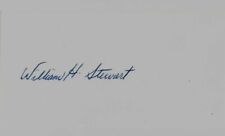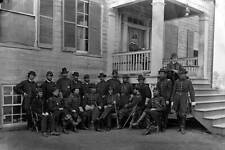When you click on links to various merchants on this site and make a purchase, this can result in this site earning a commission. Affiliate programs and affiliations include, but are not limited to, the eBay Partner Network.
Up for sale the "10th Surgeon General" William H Stewart Hand Signed 3X5.5 Card.
ES-7503E
William
H. Stewart (May
19, 1921 – April 23, 2008) was an He was appointed tenth Surgeon
General of the United States from 1965 to 1969. Stewart was
born in Minneapolis, Minnesota. He
began college at the University of Minnesota and
completed his undergraduate degree at Louisiana State University (LSU) (1942), after his father
moved the family to Baton Rouge during World War II to chair the pediatrics department at LSU. Stewart earned his medical
degree through an accelerated program at the LSU Health Sciences Center in New Orleans, under the auspices of the U.S. Army's Specialized Training Program. After graduating in
1945, he received a commission as a first lieutenant, kept an inactive status during General
Hospital, and then served as a Medical Officer at Brooke General Hospital in San Antonio, Texas (1946–1947).
After a brief stint at the at Fort
Snelling, Stewart returned home to Baton Rouge for a Hospital (1948–1950). His plans to enter private
practice were cut short by the outbreak of the Korean War and his remaining military obligation. Stewart's
introduction to the Public Health Service (PHS)
came when the Air Force agreed to transfer him into the first class of Langmuir's Epidemic Intelligence
Service (EIS) at the Communicable Disease
Center (CDC). In February 1951, Stewart accepted a Commission
in PHS's Inactive Reserve as a Senior Assistant Surgeon. Four months later, he
was dispatched as the sole physician epidemiologist to CDC’s Thomasville, Georgia Field
Station. As an EIS Fellow he worked under Dr. James Watt (soon to be named Director of the new National Heart Institute)
(NIH), studying how fly eradication dampened outbreaks of
childhood diarrheal diseases and about DDT's
efficacy in combating typhus. After EIS, Stewart followed his
mentor to the National Heart Institute and became a trainee at the Grants and
Training Branch of the National Heart Institute (November 1953). When PHS
opened a Heart Disease Control Program under its Bureau of State Services (BSS),
Stewart was named chief (October 1954), returning to NIH in July 1956 to lead
its Technical Services Branch. In April 1957 then-Surgeon General LeRoy
Edgar Burney recruited junior officer Stewart to join his
staff. Stewart managed a number of projects related to planning, administrative
reorganization, and health professions education and led the Office's applied
research unit—Public Health Methods—from July 1958 through 1961. With some form
of national health insurance widely
anticipated to be imminent, Stewart became an inhouse expert for PHS on issues
related to health services delivery and third-party
reimbursement. In November 1961 he returned to BSS to head a
new Division of Community Health Services devoted to these
issues, then from January 1963 through August 1965 worked closely with Medicare architect Wilbur Cohen (the Department
of Health, Education, and Welfare (DHEW) Assistant Secretary
for Legislation), as an Assistant to Dr.
Boisfeuillet Jones, the Special Assistant for Health and Medical
Affairs (subsequently renamed the Assistant Secretary for Health). Stewart’s
nomination to be Surgeon General on September 24, 1965 came as a complete
surprise. Only weeks earlier, then-Surgeon General Luther Leonidas Terry had
appointed him to succeed James Watt as Director of NIH. Stewart found himself
at the helm of PHS under pressure both to expand his agency because of Medicare
and Medicaid and to cut back because of the war in Vietnam and a slowing of the phenomenal growth of
NIH. His response was to weave PHS into the Johnson Administration’s creative approaches to
federalism, using the highly successful Hill-Burton hospital construction program as a starting
point for efforts to improve access to services through government planning.
Soon after Stewart became Surgeon General, for example, PHS took on the
high-profile and critical task of certifying the nation’s hospitals for
compliance with Title 6 of the Civil Rights Act of 1964,
prior to the July 1966 implementation of Medicare reimbursement for health
services. Public concern that NIH research become the basis for improved care
and greater access to care moved DHEW to convene the DeBakey
Commission, whose 1964 Report Stewart used as the basis for PHS’s
Regional Medical Program (the Heart Disease, Cancer, and Stroke Amendments of
1965). States relations programs, including categorical grants-in-aid to state
health departments, were revamped along the lines of urban planning, as
the Comprehensive Health Planning Act (also known as the
Partnership For Health Act of 1966 and its 1967 Amendments) bypassed state
health departments to award grants directly to local government and community
not-for-profits, coordinated through state (so-called "section 314a")
and nongovernmental ("section 314b") planning agencies. Cycles of administrative upheaval accompanied these
dramatic changes at PHS. The first of two major reorganizations reflected
nearly a decade’s worth of planning, articulated in terms of operations
research and functionally oriented management theory (known as program planning
and budgeting). In contrast, the second was a dramatic reshuffling of the
organizational deck by Acting Secretary of DHEW and Medicare program architect
Wilbur Cohen. When Stewart became Surgeon General, he inherited an agency over
which he, a career officer in PHS’s Commissioned Corps, exerted line authority.
PHS enjoyed strong relationships with state health departments, the American Medical
Association, and budgetary largesse for the National Institutes of
Health. As a result of the two reorganizations, his successor would
report as a senior advisor to the Assistant Secretary for
Health and Scientific Affairs, a political appointee, and would not
even be appointed until well into President Nixon’s first term. Stewart’s influence was
more visible during the first reorganization than the second. Reorganization
Plan No. 3, enacted April 25, 1966 and effective the following January (1967)
gave explicit attention to the issues of access to services and environmental
health. The CDC served as a model, with its decentralized administration,
relative independence from Washington, and strong public constituencies. PHS
activities were arranged into five Bureau-level units: Health Manpower
(education programs); Health Services (concerning access, Medicare, and
Medicaid); Disease Prevention and Environmental Control (environmental health);
the National Institute of Mental Health (research and
clinics); and the National Institutes of Health (basic and clinical research). PHS’s
new organizational chart was quickly outmoded. When the second reorganization
took place the following spring (1968) the Assistant Secretary for Health and
Scientific Affairs for DHEW, Dr. Philip Lee, replaced the Surgeon General as
head of PHS. The five Bureaus were consolidated into three: the National
Institutes of Health; a new Health Services and Mental Health Administration (HSMHA);
and a new Consumer Protection and Environmental Health Service (CPEHS),
which contained programs from the short-lived Bureau of Disease Prevention & Environmental Control and
the Food and Drug
Administration, formerly an independent agency that had reported
directly to the Secretary of DHEW. From the optimistic days of the Civil Rights
Act of 1964, the War on Poverty, and
Medicare, PHS entered into an era characterized by more complicated bureaucratic maneuvering, increased public involvement,
and renewed efforts to control Federal health expenditures.









